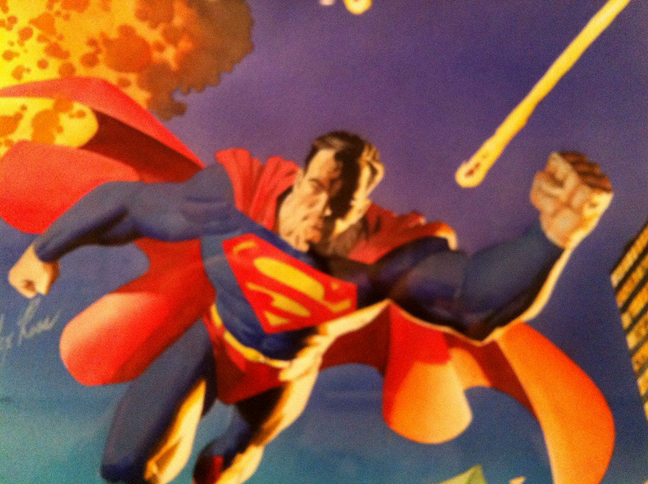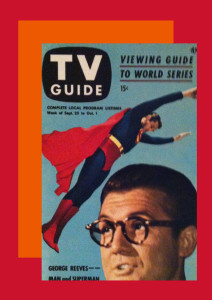Strange Visitor
“Look, up in the sky!” “It’s a bird!” “It’s a plane!” “It’s . . . ”
The anxious and confused cries of the earthbound are calmed by an offscreen narrator who explains that a strange visitor from a distant planet, disguised as a mild-mannered reporter, came to ensure truth, justice, and (before globalization) the American Way.
Metropolis was regularly under siege by evil-doers who knew the quickest way to bring down this urban bastion of the American Way was to kidnap Daily Planet reporters Lois Lane and Jimmy Olsen. They were friends of both Superman and Clark Kent (little did they know) and their prized heads were key to demands being met. Sometimes Clark himself would get captured with his less capable colleagues, but that only made victory certain, barring any kryptonite on the premises, or x-ray vision thwarting lead walls.
I’m quite familiar with this classic TV show. I was entranced by it. One of my favorite past-times was to have mom pin a bath towel to my t-shirt so that I could fly around the house saving my endangered metropolis. It was great make-believe, hampered only by the fact that my bath towel cape did not bear the fantastic “S” shield and was likely powder-puff pink, rather than bright bold red.
Super Silly Existential Extra Anxious Heroes
While I still think it was a fun TV show, it was all quite silly. A super guy from Smallville, by way of Krypton, sticks on a pair of horn rimmed glasses and convinces the whole country that he is only a mild-mannered reporter? Great Caesar’s Ghost!
Okay, so superheroes portrayed on early television were a bit silly. This was before “heroes” devolved into angst-ridden, dark and depressive loners who teach us that cynicism is the proper response to any real hope of truth, justice, and, globalization forbid, the American Way.
Our post-modern heroes still take out the bad guys, but only to find themselves in a funk over who they are and why they do their superhero stuff. They suffer existential crisis and inner conflict. All that secret identity must wear on one’s self-awareness. They mope, slink back into their secret civilian lives and plod through until the next global threat requires their attention. I suppose not all modern superheroes are like this, but there does seem to be more bummed heroes now than in the old days.
Superman, aka Clark, was a pretty upbeat guy. He had a winning smile and a firm handshake (obviously). With a pleasant, wry sense of humor, and better than average eyesight, Superman seemed genuinely happy to rescue Lois and Jimmy from the clutches of death. He took great satisfaction in his work, and when the job was finished he happily put on his gray flannel suit, horn rimmed specs and returned to reporting for the Daily Planet. He knew who he was and suffered no guilt for bumping a few hoodlum heads together. Metropolis was all the safer with Superman on the watch.
No doubt about it, Superman was, for me, the best. I liked that he didn’t need a cave, off-shore warehouse of weapons, an underground bunker full of gadgets, or a bubble topped car with Caddy fins. Sure that stuff looked cool but Superman was cool, as in calm, collected, and capable. The cape and tights were his only flair, and they were just a kind of uniform. They didn’t protect him or enable him to fly. He probably only wore them so that people could see he was neither bird or plane.
Superhero stories are great fun, but they’re more than fun. They’re true.
Super stories begin on a pleasant day with the sun shining, kids laughing, and grown-ups minding the store. Then bam, something goes terribly wrong. The usual heroes: police, military, moms, dads, teachers, athletes, do their best, but this day is worse than any other day. This day brought something so bad that only a superman can save it.
There’s a reason we tell these stories, a reason we make these movies. You know, I know, the people of Metropolis know, that something is wrong, terribly wrong. We still haven’t eliminated evil and death, those most serious of things that are wrong. We try to tell ourselves that we’ll eliminate evil and teach everyone to play nicely, but generation after generation repeats the sins of their fathers. We feed the fantasy of eliminating death, but that isn’t panning out. Metropolis is still filled with hospitals, hospices, and hearses.
But we still tell those stories. Those stories about a superhero coming to the rescue. Coming to do what we can’t do ourselves. Coming to save the day. To save us. We will keep telling those stories, because their plots are set in a real story, a true story.
Most of you know that I make my living illustrating stories, mostly biblical or religious stories. It’s a common misunderstanding that the Bible stories I illustrate are stories of ancient heroes, heroes of faith. Sometimes the stories focus on an individual who is said to have done “great things for God”, showing courage and strength of moral character in the midst of weak and faithless people. Well, that’s not exactly the way it really was. Yes, people like Moses and Joshua, Gideon and David, did “great things”, but they did many really, really awful things, and they are not the heroes of the Bible. There is only one hero in the story and he has come to save the day, and to save you.
I’ve no idea how many of you reading this find that story silly, ridiculous and simply not true. We could have lively discussion about the details, the historicity, and the verity of that story. I’ve no idea if you would come away convinced, but I’m pretty sure you want the basic story to be true. You want there to be a superhero and you will, so long as you have breath, come back to stories about a heroic rescue and Lois and Jimmy being swooped up and carried to safety.
The above images, except for BAM, were photographed at the Cartoon Museum in San Fransisco.




Yes, we know the ultimate Super Hero! I am sending this blog to my husband who loves the old Superman show!
I got it!
Received
Test comment